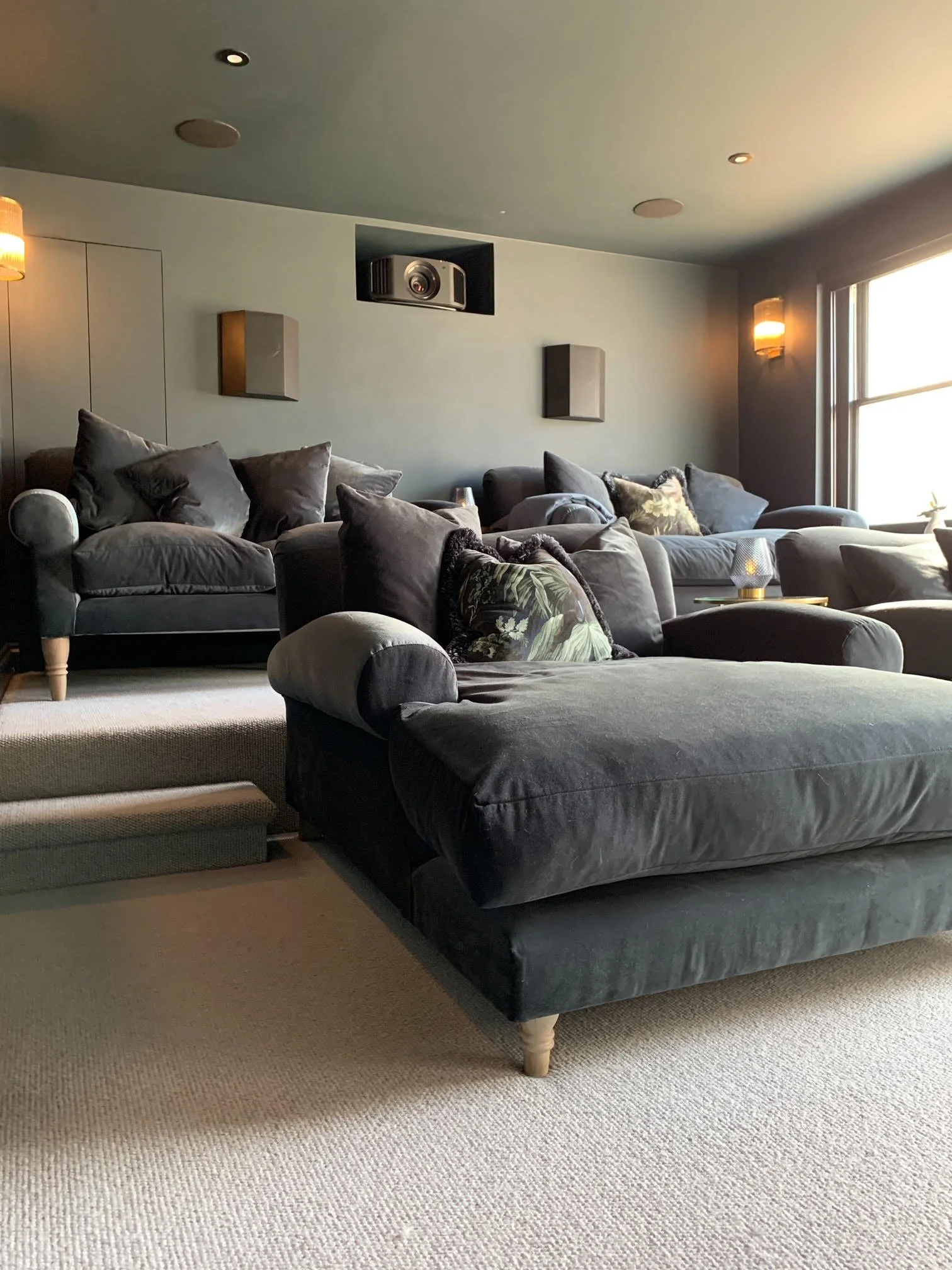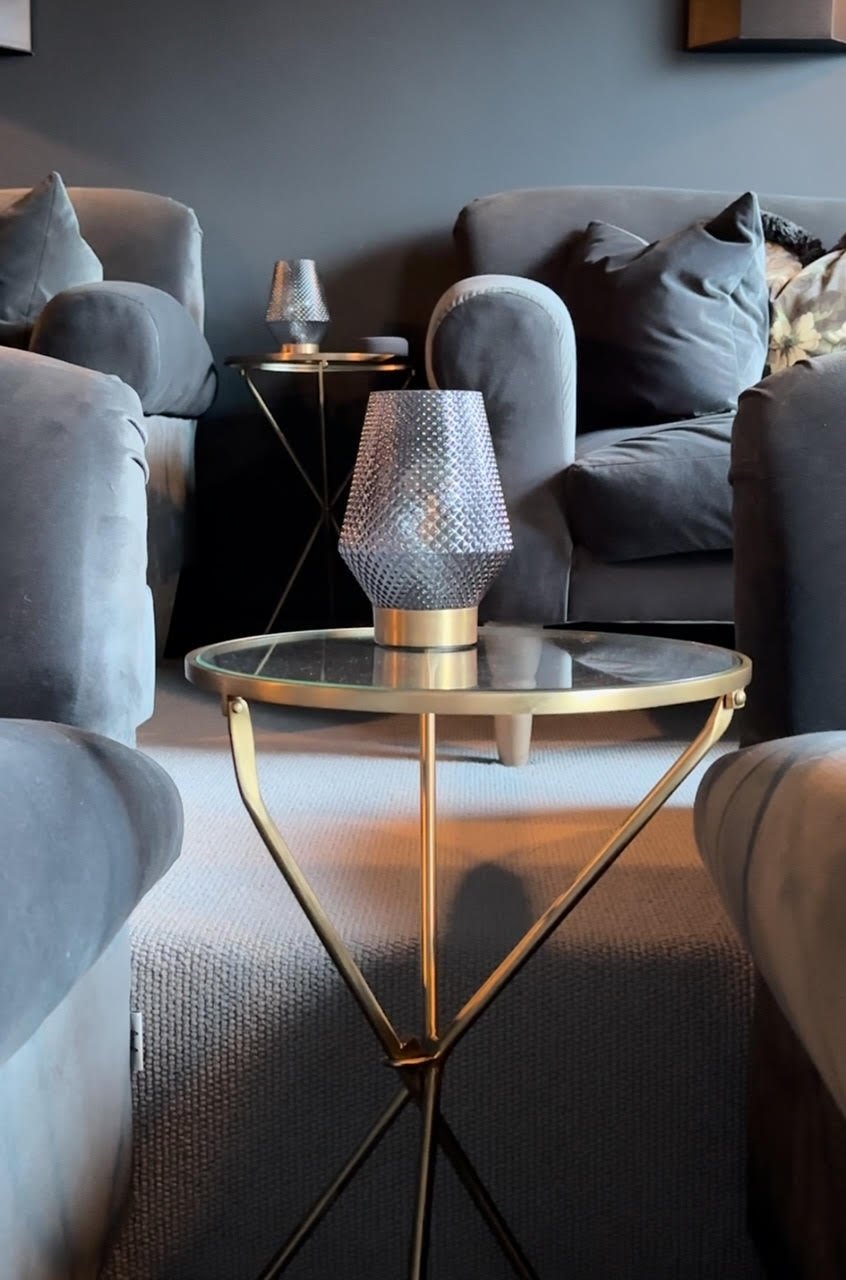How to create a Soho House-style cinema room
A HOME cinema room had long been on my husband’s wish-list when I met him in 2004.
Such was his obsession with all-things movie related, the first thing he ever bought me in the early days of our relationship was a DVD player from Tesco –oh the romance – because I had readily given mine up in a divorce settlement a few years earlier and he simply could not believe I didn’t own one.
It’s fair to say audio-visual equipment has never been a big passion of mine. My priority when we got our first house together was to sell his extensive collection of speakers-on-stands on eBay and to dispose of a highly-veneered Hi-Fi cabinet at the tip. He did manage to hold onto a pair of absurdly large subwoofers that I insisted had to sit on the floor, behind the sofa, where, allegedly the sound was muffled. 😊
Fast-forward 15 years to our current home which we bought primarly because it had a basement flat offering potential to expand the main house’s living space down into the lower floor and maximise our investment. My husband’s cinema room dream was about to be realised, but it was not without its trade offs.
We could not spend more on a cinema room than we did on the new kitchen, I insisted, and Joey & Chandler style leather recliners were an absolute deal breaker. The budget for the kitchen was quietly upped (I mean!!) and our respective cinema room roles agreed, with all things tech under my husband’s jurasdiction and the overall design aesthetic in my hands.
If you’ve seen one, you’ll know, that there is nowhere sexier than a Soho House cinema, with its plush 1920s glamour, luxe velvet sofas and individual brass side tables for cocktails & nibbles. A few years earlier, we had been given a voucher for the Electric Cinema in Notting Hill. Truth be told I couldn’t tell you what we watched as I spent the entire time basking in the glow of the décor and the cocktails. I even had a little nap. It was an experience just BEING at this cinema, and this was the feeling I really wanted to capture in creating our own.
Not everyone has the capacity to dedicate a whole room to a home cinema, or the budget to invest in specialist AV kit, but even a snug or family room with a TV can feel like a Soho House private screening room (it’s how you pitch it 😊) with some thought and planning.
So, what do you need to know?
Our ‘Soho House’ style cinema room
Room Size
Everything comes back to this. The size & location of the screen, how many seats, where to position them…. online recommendations suggest minimum room dimensions of 6m long by 4.5m wide for a cinema room, but ours is 4.6m x 3.6m and it works just fine.
Even a 3m² square room can work if you have the right size of TV, because it’s all about…
Viewing Distance
All men think size matters and the bigger (the TV) the better, but you need to focus on achieving the optimum balance between screen size and viewing distance. Obviously the larger the screen, the more immersive the experience, but you don’t want to feel the screen is too close to watch it comfortably or that it’s overpowering.
A screen with a 4K or 8K resolution has a greater pixel density than a standard TV meaning the image will be more vivid and detailed so it’s important to determine what screen you have, or intend to buy, when planning the space, as a lot depends on that.
TVs are helpfully bracketed by size between 32” – 85” (although you can get larger) and projector screens are usually larger still. You may not already know, and it’s not at all obvious unless someone tells you, that screen size is measured diagonally from a bottom corner to a top corner and does not include the frame or bezel. You’re welcome.Once you know the size of your screen, you can calculate the optimum viewing angle to determine where to put your seating. The Society of Motion Picture and Television Engineers recommends sitting at a distance where the screen fills up a minimum of 30° of your field of vision for a good experience, i.e field of vision being what your eyes can actually take in when you're positioned in front of the screen. For recommended viewing distances based on your screen size see the table below – note mixed usage distance means for a more generic TV room at a 30° viewing angle, compared to cinema room recommendation of a 40° viewing angle, or just split the difference at 36°
The Soceity of Motion Picture and Television Engineers recomended viewing distances
Tiered Seating
Admittedly probably not an option in your family snug, but if you’re creating a cinema room from scratch and want additional rows of seating consider elevating the rows behind. Some timber joists and plywood are all that’s needed to create tiered flooring, our second tier is 28cm up from the original floor, with a step at 14cm, so no heads obstructing the view or kids booster cushions needed.
Sound
While in an ideal world your cinema room would be sound-proofed (our isn’t, although it does have acoustic plasterboard) if your budget and patience doesn’t stretch to cladding the walls in acoustic panels there are steps you can take to improve the sound quality in your home cinema room.
Carpet is a must. While admittedly my husband and I came to blows about this to start off with because I had hoped for the same wooden flooring throughout the basement level, I can’t tell you how happy the carpet in the cinema room makes me now. It’s warm and cocooning and, more significantly, it absorbs sound and reduces echo.
Soft cushiony seating and thick drapes hanging either around the walls and/ or at the windows will also contribute to the audio experience, although truth be told our cinema room only has window blinds so curtains are not an essential.
Our 100” projector screen is 2.5m away from the centre of the first row of seating
Light
When watching a movie you want the room to be in complete darkness, so those drapes or blinds must be black-out. Window-less rooms are recommended online, but in my view windows are a god-send in the summer in an otherwise airless room squished with 8 people and all that heat-generating tech.
Any lighting or lamps that reflect in the screen will ruin the cinematic experience. Ideally sync your lighting to a smart phone app so you can automate lighting from your seat as people get up for a comfort break, it’s all too easy to trip over a sleeping dog in the dark and I speak from experience.
If you really want to go the extra mile, avoid any reflective surfaces that can bounce sound, or light around the room and that includes glass photo frames.
Wall lights from Pooky.com (the Roddy £140). The poster is framed with acrylic glazing
The Soho House look & feel
Every Soho House cinema shares at least one key design piece and that is velvet seating. Whether in a toning or contrasting shade, nothing beats velvet for comfort and luxury and nowadays velvets are widely available in an easy clean finish, which proves helpful for wine spills and those damn chocolate buttons you always end up sitting on.
Our sofa’s are in Loaf’s Liquorice Blue Clever Velvet, closely colour-matched to the Farrow & Ball archive colour Black Blue (no. 95) on the walls & ceiling, to create a calm continuity to the space.
I went with a dark blue palette as a twist on the ubiquitous cinema red, but if I had my time again I’d love to do a really dark red, like Farrow & Ball Preference Red (no. 297) with a matching velvet (Loaf Drenched Damson) or Farrow & Ball Studio Green (no. 93) with Loaf Christmas Tree Clever Velvet. Just gorgeous.
We took the wall colour over the ceilings too and bought some light relief with the carpet colour, which is a very pale grey.
Adding individual brass & glass side tables is signature Soho House – I found a great dupe for their Cinema Side Table (Soho Home £395) from Loaf, the Tria at £95 which is no longer available but the style - glass, brass, pedestal base - is easy to enough to source.
The Tria side table from Loaf.com (no longer available but easily enough to source similar
AV Kit
As you may have picked up, AV equipment is not my specialist subject and speaker systems remain a topic that I generally veer away from but it’s true that a well-placed surround sound system can make or break your cinema room experience.
Broadly speaking, you need a central speaker(s) above or below your screen (or behind if it is acoustically transparent) as well as speakers to the left and right of your seating position. You may want to build in overhead speakers if you’re renovating the room, and potentially place further speakers behind you.
Speakers should ideally be at head height, angled towards the viewing seats. The more you have, the more immersive the experience, so if you can’t hide them in the walls, you might want to put them onto stands around the room…...arrgh there I’ve said it. I really am dreadfully sorry. A strategically placed trailing plant can work wonders.
On the AV side, if you want to invest in some kit more sophisticated than a Smart TV / TV with set-top box it’s worth speaking to a cinema room company to discuss your specific needs and budget. We used & can recommend ATI UK https://atiuk.net/home-automation/home-cinema (not an ad).
The AV kit tucked away in a cupboard
What I CAN tell you on the AV front is that you’ll need hard-wired internet access as well as ventilation for your kit, ideally an AV rack with grided shelves in a well-ventilated cupboard away from the heat of the projector or screen.
And on this point, despite any kit upgrades you make, you’d be wise to hang onto that DVD or Blu-Ray player.
Yes, Love Actually might be widely available on all the film channels but there is nothing more annoying than paying £5.99 to watch a movie you’ve had on DVD since 2004.
Which is why, incidentally, that 2004 Tesco DVD player is still going strong. Perhaps a very thoughtful gift after all. 😊






